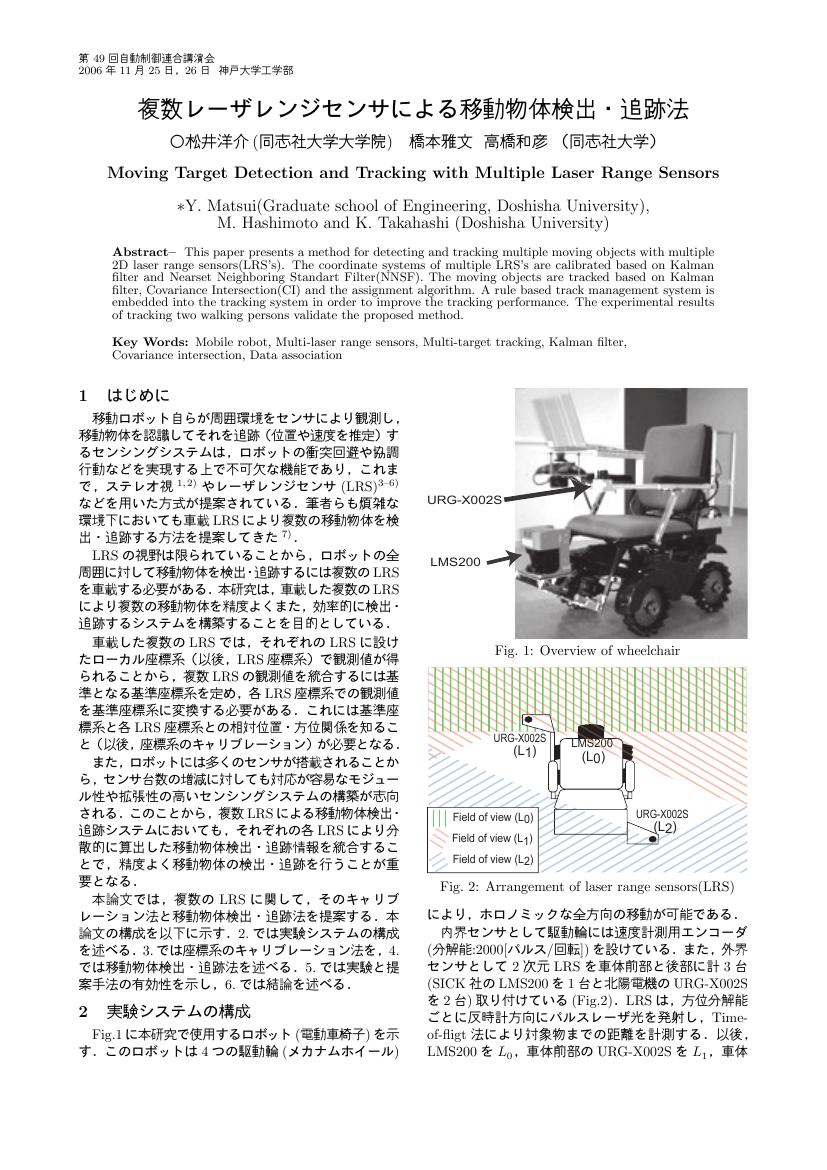2 0 0 0 OA NDTスキャンマッチングに基づく車載レーザスキャナ観測点群の歪補正
- 著者
- 乾 公昭 森川 昌英 橋本 雅文 所谷 康平 高橋 和彦
- 出版者
- 一般社団法人 日本機械学会
- 雑誌
- 日本機械学会論文集 (ISSN:21879761)
- 巻号頁・発行日
- vol.83, no.854, pp.17-00061, 2017 (Released:2017-10-25)
- 参考文献数
- 21
- 被引用文献数
- 2
This paper presents a method of correcting distortion in 3D laser-scan data from in-vehicle multilayer laser scanner. A robot identifies its own 3D pose (position and attitude) in a laser-scan period using the normal-distributions transform (NDT) scan-matching method. Based on the pose information, the robot's pose in a period shorter than scan period under the assumption that the robot moves at almost constant linear and turning velocities. The estimated pose of the robot is applied to map laserscan data onto a world coordinate frame. Subsequently, the robot again identifies its own 3D pose from the mapped scan data using NDT scan matching. This iterative process enables the robot to correct the distortion of laser-scan date and accurately map the laser-scan data onto the world coordinate frame. Two methods for correcting the laser-scan data are presented: linear-interpolation based and Kalman-filter based methods. The former applies the extrapolation and interpolation to estimate the vehicle pose, while the latter applies the prediction, estimation, and smoothing. Experimental results of mapping a signal light in a road environment show the performance of the proposed two methods.
1 0 0 0 OA 複数レーザレンジセンサによる移動物体検出・追跡法
- 著者
- 松井 洋介 橋本 雅文 高橋 和彦
- 出版者
- 自動制御連合講演会
- 雑誌
- 自動制御連合講演会講演論文集 第49回自動制御連合講演会
- 巻号頁・発行日
- pp.229, 2006 (Released:2011-04-17)
1 0 0 0 OA レーザスキャナを搭載する複数移動ロボットによる非GNSS環境下での協調移動物体追跡
- 著者
- 金生 翔太 橋本 雅文 余田 侑仁 高橋 和彦
- 出版者
- 一般社団法人 日本機械学会
- 雑誌
- 日本機械学会論文集 (ISSN:21879761)
- 巻号頁・発行日
- vol.83, no.854, pp.17-00138-17-00138, 2017 (Released:2017-10-25)
- 参考文献数
- 26
This paper presents a laser-based tracking (estimation of pose and size) of moving objects using multiple mobile robots in Global-navigation-satellite-system (GNSS)-denied environments. Each robot is equipped with a multilayer laser scanner and detects moving objects, such as people, cars, and bicycles, in its own laser-scanned images by applying an occupancy-grid-based method. It then sends measurement information related to the moving objects to a central server. The central server estimates the objects’ poses (positions and velocities) and sizes from the measurement information using Bayesian filter. In this cooperative-tracking method, the nearby robots always share their tracking information, allowing tracking of invisible or partially visible objects. To perform a reliable cooperative tracking, robots have to correctly identify their relative pose. To do so in GNSS-denied environments, the relative pose is estimated by scan matching using laser measurements captured by both sensor nodes. Such cooperative scan matching is performed by 4-points-congruent-sets (4PCS)-matching-based coarse registration and Iterative-closest-point (ICP)-based fine registration methods. The experimental results of tracking a car, a motorcycle, and a pedestrian with two robots in an outdoor GNSS-denied environment validate the proposed method.
- 著者
- 上杉 謙介 橋本 雅文 高橋 和彦
- 出版者
- 一般社団法人 日本機械学会
- 雑誌
- 日本機械学会論文集 (ISSN:21879761)
- 巻号頁・発行日
- vol.83, no.851, pp.17-00129-17-00129, 2017 (Released:2017-07-25)
- 参考文献数
- 13
This paper presents a method for detecting and cancelling motion artifact related to standing and walking in a functional near-infrared spectroscopy (fNIRS) signal. Our fNIRS device has 22 channels. The motionless fNIRS signal from each channel is represented by a fourth-order autoregressive model (AR model), and the related parameters are estimated based on the motionless fNIRS signal using Yule Walker equation. The motion artifacts included in the fNIRS signal are cancelled using the Kalman filter constructed from the AR model. However, the cancellation may be insufficient when the motion artifacts are strong. To determine in which fNIRS channels the motion artifacts are cancelled insufficiently, we apply an observation prediction error related to the Kalman filter and a discrete Fourier transform. The brain activity of the user is then recognized from those fNIRS channels in which the motion artifacts are cancelled sufficiently. To evaluate the proposed method, a mobile robot is controlled using an fNIRS devise as worn by 10 subjects while standing, walking, or sitting. The success rate of brain-activity recognition by the proposed method was 64.2%, whereas that without the proposed method was 54.0%.
1 0 0 0 高性能GaN系青色LEDの試作研究
1.前年度に引続き、GaNの高品質MOVPE結晶成長条件下でZnを添加することによりMIS構造に必要な抵抗率の高いi層を実現し、MOVPE法による高性能MIS型青色LED(発光効率0.3%)を実現した。2.カソ-ドルミネッセンス(CL)法によりZn添加GaNの発光微細特性及び発光スペクトルを評価した結果、「GaH表面微細構造」と「発光波長及び発光強度」の間に密接な関係があることを見出し、面内で均一な青色発光を得るための成長条件を明らかにした。3.MOVPE法によりMg添加GaNの結晶成長を行い、以下の結果を得た。(1)Mg濃度はMg原料流量に対し線形的に制御できる。(2)Zn添加の場合と異なりMgの添加効率は基板温度によらず一定である。(3)Mg濃度を制御することにより室温のPL測定において青色発光(440〜460nm)を得た。(4)電子線照射処理を施すことにより、青色発光強度が1桁以上も増加すること、かつp形GaN(正孔濃度〜10^<16>cm^<-3>)が得られることを見出した。(5)pn接合形LEDを試作し、その発光スペクトルを測定したところ、青紫色及び紫外発光が観測された。以上の結果、Mg添加はGaN系短波波長発光素子の作製に極めて有効な方法であることが明らかになった。4.GaN上にGaAlNを成長させヘテロ接合の作製を行った結果、GaAlN層にクラックが発生することが分かった。このクラック発生はGaAlN層の組成及び膜厚を制御することにより抑制できることが明らかになった。またこのクラック抑制技術に基づきGaNとGaAlNの多層構造を作製した結果、表面平坦性の優れた多層膜が得られた。
1 0 0 0 9p-F-5 局部磁場オシリスターの発振モード
- 著者
- 有住 徹弥 梅野 正義 橋本 雅文 掘場 康孝
- 出版者
- 一般社団法人日本物理学会
- 雑誌
- 日本物理学会年会講演予稿集
- 巻号頁・発行日
- vol.19, no.3, 1964-10-08
